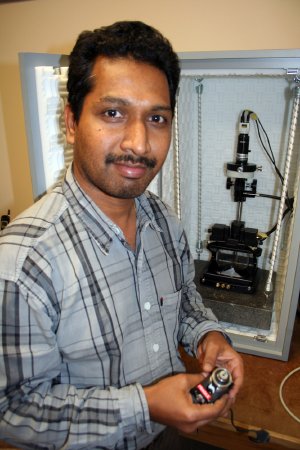Dec 30 2009
Federal research dollars will help South Dakota State University scientists build a first-of-its-kind microscope that could ultimately help scientists at SDSU and elsewhere develop better solar cells for converting sunlight to electricity.
 SDSU professor Venkateswara Bommisetty has a National Science Foundation grant to build a first-of-its-kind microscope that could help scientists build better solar cells.
SDSU professor Venkateswara Bommisetty has a National Science Foundation grant to build a first-of-its-kind microscope that could help scientists build better solar cells.
Professor Venkateswara Bommisetty in SDSU’s Department of Electrical Engineering & Computer Science will build a new photoactivated, scanning probe microscopy tool that makes significant improvements on the existing scanning probe microscope.
“It will simultaneously measure efficiency-limiting factors by identifying defects, their structure and locations in a wide variety of solar cells, that existing microscopes are not able to do,” Bommisetty said.
“This instrument will also probe the light-energy conversion mechanisms in other optoelectronic devices such as light-emitting diodes.”
The new equipment will be developed by an SDSU team under Bommisetty’s leadership. Bommisetty received $456,000 for development of the scanning probe microscopy tool so that he and his colleagues can study photoactivated processes — processes activated by light — at the nanoscale. The grant is from the National Science Foundation. SDSU and its Department of Electrical Engineering and Computer Science are supplying an additional $200,000 to make a total project of about $650,000.
Bommisetty’s career as a researcher has focused in part on developing better technologies to make such measurements at the nanoscale level.
“It is extremely important. It is a very hot area of research,” Bommisetty noted. “Researchers elsewhere are facing the same problem. Application of these new technologies for the first time is important to help SDSU make its mark in developing new solar cell technologies.”
The grant will create two new jobs in Brookings as Bommisetty hires a postdoctoral researcher and a graduate student to build the microscopy tool under his direction, acquiring valuable skills in the process.
The grant will also help acquire high-tech components, such as various types of laser generators and scanners necessary to build the scanning probe microscope.
There are three types of solar cells, Bommisetty noted: inorganic solar cells based on materials, such as silicon; organic solar cells that use carbon-based polymers; and hybrid solar cells that combine different technologies.
“The faculty members at SDSU are working on all three types of solar cells. In each of the respective solar cells, the challenges are different,” Bommisetty said. “We know that all these technologies can be far more efficient than what they are today. The problem is, we don’t know what factors are limiting the efficiencies of these solar cells. This microscope is specifically designed to identify defects that limit solar cell efficiency.”
Developing such a microscope has been the goal of solar cell researchers for a long time. Importantly, the scanning probe microscopy tool is designed to measure different variables at the same time — a key advance in such technology.
“Simultaneous is a key word for our work, because if we measure one variable at a time, we won’t know if we are modifying other variables during measurement or not,” Bommisetty said. “If we measure them all at the same time, we can determine the exact problem and can effectively develop methods to address the problem.”
Bommisetty said SDSU already is acquiring components and researchers will begin assembling the new scanning probe microscopy tool in 2010. One version of the microscope will go into the molecular electronics bay of a new $1.25 million SDSU cleanroom, planned for construction in 2010, so that scientists can use it to test new solar cells.